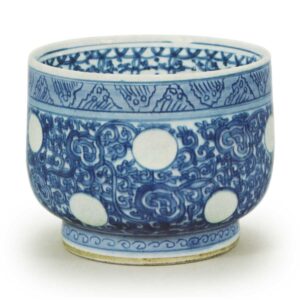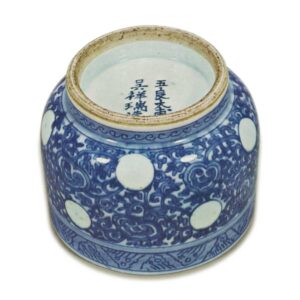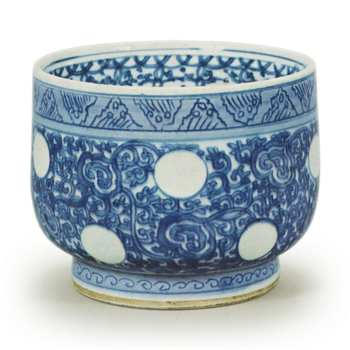

Nezu Museum
Height: 7.6cm
Diameter: 9.2cm
Outside diameter of foot ring: 6.7cm
Height of foot ring: 1.2cm
Shoban-style porcelain, which is a type of underglaze blue and white porcelain, has been highly prized since ancient times as the finest type of underglaze blue and white porcelain for use in the tea ceremony. The pure white body, the vivid blue color, and the clear, glossy glaze are truly the finest in terms of the quality of the dyeing, and when combined with the ingenuity of the shapes and patterns, they have won the admiration of tea ceremony enthusiasts. The types of tea utensils and tea bowls, incense containers, water jars, bowls, plates, sake cups, etc. are limited to tea utensils and tea bowls for tea ceremonies and stone tools, and sometimes they are inscribed with the name “Gora Taifu Gosho Zuo”, so regardless of whether they are inscribed or not, this type of tea utensil is widely referred to as “Shosui”.
In the book “Kokin Wakan Shodogu Kenshisa” (A Guide to Ancient and Modern Japanese and Chinese Tools) compiled in 1704, it is stated that “Shourui-dyeing is of the highest quality, and the term Shourui refers to the best of the Nanking wares”. As is obvious from this, Shourui ware was made at Jingdezhen kilns in Jiangxi province, the center of pottery production in China.
The fact that their use was limited to the unique Japanese tea ceremony is the same as that of the so-called old-style dyeing of ceramics, and the fact that Shōzu was made as a pure tea ceremony tool, such as the orange-shaped water jug and the shoe-shaped tea bowl, is even more striking, and it is said that they were ordered from Japan. The age of the tea bowl can be roughly estimated to be from the end of the Ming Dynasty to the beginning of the Qing Dynasty, the so-called transitional period, based on the elements of the pattern, the foot ring, the taste as a tea utensil, and the fact that it is inscribed with the name of Enshu. The most important piece of evidence is a tea caddy with the inscription “Dai-myo-sutei-hachi-nen” (8th year of the reign of Emperor Shoutoku of the Ming Dynasty) in the collection of the Ashiya Teikoku Museum of Art. This suggests that the next type of tea utensil to appear after the Tenkei Kosometsuke tea utensils was the Shourui. The shape of the Kosometsuke tea utensils is quite thick, and the Shourui is also thick. This is because they tried to imitate the style of Japanese tea utensils, but the artisans of that region were not used to making them, and in particular, the Kosometsuke tea utensils look quite awkward. However, the thick, glossy glaze of the Shōzu tea bowls adds a sense of refinement and elegance, and the careful technique used to make them enhances their appearance.
Next, the inscription “Goryo Taifu Goshoryu Zou” is said to be the name of a Japanese tea master who went to China in ancient times and made this tea bowl there, but in recent years, according to the research of Kikutaro Saito ‘s research, Goro Daifu is understood to be the name of Wu Xiangrui, and in short, it seems to be attributed to the fact that it is the work of Wu Xiangrui, a Jingdezhen potter, and there are many potters with the surname Wu in Jingdezhen.
This tea bowl is well known by the name of Shourui Suijaku, and the ten white round motifs that stand out against the vivid blue arabesque pattern are extremely impressive, and I would like to call the design superb. On the lower part of the rim and the sides, there are bands of line carving, and on each of these, there is a round carving in the style of either a gall or an arabesque, and a light indigo dami has been applied. The indigo arabesque on the body is also elegant and tasteful, but the upper and lower lapis lazuli ground and the elegant design are also rare. The rim design is also very light and elegant. The foot ring has been carefully scraped to form a kamaboko shape, and dotted with sand to give it the appearance of the so-called “auspicious sesame soil”. The glaze has been scraped to form a single character on the inside and outside, and the foot ring bears the inscription “Gora Taifu Goshōzu”, which is particularly outstanding. There is also a little ash on the inside.



